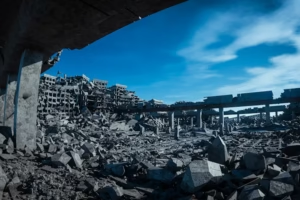[This piece had its origin as a commissioned front page article for Christian Courier and a shortened version was published in the Easter edition. Here I post a longer version of the article as Part One of my extended reflection on Easter among the ruins. This version was prepared for Easter Sunday at St. Andrew’s Presbyterian Church in Lindsay, Ontario. The text for Part One is Isaiah 65.17-25.]
Read Isaiah 65.17-25
Can there be resurrection
among the ruins?
Dare we imagine new life
rising from these streets of death?
Might hope be born
in the face of such despair?
Is it possible that desecration
could give way to creation anew?
Were these the questions
haunting the prophet standing
in the ruins of Jerusalem;
a city that never could live up to its name,
that never was a city of shalom?
Are these our questions
bearing witness to the ruins of Gaza,
the constant assault on the West Bank,
the genocide of a people?
From the bombed out cities of Ukraine
to the massed murders in Sudan,
from hunger in Burkina Faso
to violence and displacement in Myanmar,
can we imagine resurrection?

Of a people?
Of a city?
Of home?
From heart crushing
division
to a culture of threat,
from a climate
emergency
to the abandonment of justice,
can we imagine resurrection?
Of a community.
Of our world.
Of compassion.
From an anxiety permeating our times
to the captivity of our imaginations,
from a debilitating sense of betrayal
to the fear that it is all collapsing,
can we imagine resurrection?
Of a dream?
Of a faith?
Of hope?
 Can we join Isaiah in
Can we join Isaiah in
the ruins of Jerusalem?
Can we hear his alluring
oracle of resurrection
speak to us in the ruins of our lives?
We know that
it will take a lot of doing
to see this undoing through.
We know that in the face
of such desolation
we need nothing less
than a new heavens and a new earth.
In the wake of the destruction of home,
in the ruins of our all-embracing homelessness,
can we get a glimpse of Isaiah’s vision
of home-restored?
Haunted by violent home-breaking
in our own lives,
in our history,
can we be liberated
to an imagination of homecoming?
Under the oppressive weight of sorrow and guilt
can joy be reborn?
Can the repulsion of defilement
be replaced by delight?
Joy and delight
in the ruins?
Can we imagine such a thing?
Yes, says the prophet,
but it all hangs on two words.
Two words in the ruins.
Two words of protest.
Two words of an alternative imagination
Two words of radical hope.
“No more.”
To embrace resurrection,
to confess that Christ has risen,
to sing hallelujah on Easter morning,
is to say “no more.”
This is a defiant hallelujah.
A hallelujah against the odds.
A hallelujah that says “yes” to resurrection,
and “no more” to the forces of death.
No more “shall the sound of weeping be heard”
in this new creation,
in this resurrection.
No more weeping in the ruins.
No more weeping for those who are lost.
No more weeping overcome by anxiety.
No more weeping in the face of poverty.
 No more shall the cry of distress rise in the streets.
No more shall the cry of distress rise in the streets.
No more immigrants round up for deportation.
No more folks “disappeared”
because they are a threat
to the state
No more cruelty sanctioned by the state.
No more lives cut short because aid was refused.
No more child mortality for lack of care.
No more young people cut down by street violence.
No more premature death of the elderly.
No more shall they build houses and remain homeless.
No more unaffordable housing.
No more displacement.
No more murdering of home.
No more cheap farm labour.
No more extractive cash cropping.
No more destructive agriculture.
No more food insecurity.
No more labouring in vain.
No more meaningless work.
No more exploitation.
No more unemployment.
 No more children
No more children
born for calamity.
No more children
raised in the ruins.
No more children
buried beneath the ruins.
No more children
sacrificed before false gods like national security.
No more.
No more.
No more.
Can we imagine such a thing?
Can we imagine such a resurrection?
Can we imagine such a depth of shalom?
Can we imagine a culture, a city, of such peace?
Here is an audacious vision of a city of delight,
in which there is an end to neglect and injustice,
an end to oppression and violence,
in the rebirth of generosity, care, and justice.
Can we imagine a world of creational peace?
Can we imagine a healed ecology of radical restoration?
Can we imagine ecological grief reborn in delight?
Can we imagine this world restored as home for all creatures?
Not without a new heavens and a new earth.
Not without resurrection life overcoming death.
Not without resurrection permeating all of creation.
And not without a resurrection spirituality.
And so there is one more “no more” that is necessary.
One more healing, without which the vision fails.
One more resurrection that is at the heart of it all.
The resurrection of God, hope made flesh anew..
No more absence.
No more alienation.
No more abstraction.
No more distance.
“Before they will call I will answer,
while they are yet speaking I will hear.”
A resurrection spirituality.